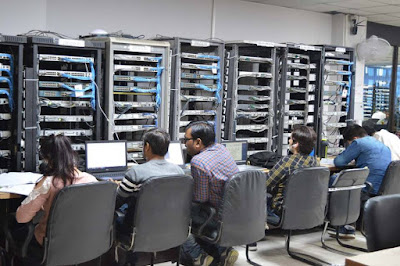A network
security engineer has a versatile job. The main task of a network security
engineer is to plan, design, optimize, implement, audit, and troubleshoot the
network security system to improve the efficiency of the organization. The
network security job is to protect the network from threats and bugs that could
attack the system and also from the existing dangers. Most importantly, they
must make sure that the networking systems can bounce back or withstand any
type of mishaps such as natural disasters and hacker attacks.
Network
Security Engineer - They should have a thorough
knowledge and a multi-branched background that should include expertise from
the fields of information technology, network and engineering, and information
security. Thus, the network engineer education is not limited to just one
field, but it has a multi-pronged approach.
Network security engineer job description
To be brief,
network security jobs include safeguarding the firm’s computer networks and
systems. They plan and implement security measures to protect the system from cyber-attacks,
hacking attacks, intrusion, infiltration, and natural disasters. They usually
work as a member of a larger IT team and report directly to the higher
management.
Network engineer job responsibilities
A network
security engineer’s responsibilities are multifaceted as they’ll have to make
the system as secure as possible. They are responsible for many different tasks
related to the security of the system. Following are some of the network
security job responsibilities:
- Planning, engineering, and monitoring the security arrangements for the protection of the network systems.
- Identifying, monitoring, and defining the requirements of the overall security of the system.
- Creating different ways to solve the existing threats and security issues.
- Configuring and implementing intrusion detection systems and firewalls.
- Testing and checking the system for weaknesses in software and hardware.
- Maintaining firewalls, virtual private networks, web protocols, and email security.
- Using industry-standard analysis criteria to test the security level of the firm.
- Occasionally replacing the security system protocol and architecture.
- Maintaining switches and servers.
Network security engineer job requirements
A network
security specialist career path should be multi-pronged. Network security
engineers should possess strong multi-tasking skills and enthusiasm for details
and should think one step ahead of cyber-criminals. They should be well prepared
to deal with high-stress situations and thrive in a fast-paced environment.
Following are the main network security engineer job requirements:
- A network engineer degree, telecom engineer degree, or BS/BE degree in computer science, cyber security or related IT fields.
- Proven work experience as a network security engineer or information security engineer.
- Experience in creating and maintaining security systems.
- Thorough understanding of the latest technologies, security principles, and protocols.
- Complete command on dealing with security systems, intrusion detection systems, firewalls, anti-virus software, log management, authentication systems, content filtering, etc.
- Understanding of the web-related terminologies and software such as web applications, web related protocols, service-oriented architectures, and web services.
- Ability to communicate and report network security incidents and issues to the upper management.
- Network engineer certifications such as CCNP Security (Cisco Certified Network Professional Security), CEH (Certified Ethical Hacker), CISSP (Certified Information Systems Security Professional), and GIAC Security Certifications.
Network engineer job salary
The average
salary of a network security specialist is around $85,000 per year according to
PayScale. The network engineer career path is very bright as they earn
handsomely and have a high job satisfaction rate. Some network engineers will
also be required to travel to different branches of an organization to monitor
the system and replace the older network architecture.





No comments:
Post a Comment